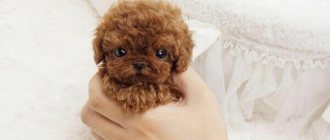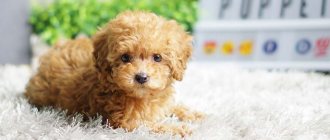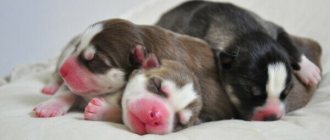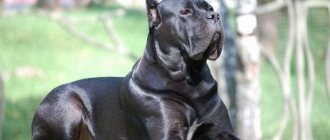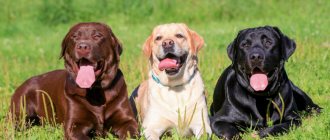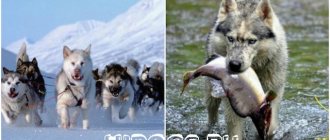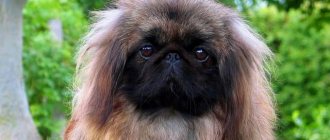Chihuahuas have been known to mankind since the time of King Montezuma (1500).
They are the smallest dogs in the world.
The height of an adult is from 15 to 23 centimeters.
Newborn Chihuahua puppies are very tiny and fragile and require special care.
What should the owner of a small pet know and be able to do?
Read our article!
Photos of what newborn puppies look like
Newborn Chihuahua puppies are born absolutely helpless: they take their first breath only after their mother has nursed them and freed them from mucus.
Their eyes and ears are tightly closed, and due to their extremely low weight, they are unable to maintain the desired body temperature on their own . It is vital for them to huddle close to their mother and littermates.
Newborn puppies have a reflex to turn towards a heat source, so for the first days they lie with their muzzle buried in their mother’s belly.
When do they open their eyes?
Two weeks after birth, puppies begin to open their eyes . At this time, they and their mother can be moved from the box bed to a more spacious playpen with a dedicated sleeping area.
Dimensions and weight
A newborn Chihuahua puppy easily fits in the palm of your hand and weighs from 70 to 160 grams . It is very rare, but it happens that there may be a “super-large” puppy in the litter, whose weight reaches up to 200 grams.
Basic facts about the breed
When buying a Chihuahua, you need to know that the dog:
- Behaves on an equal footing with representatives of larger breeds. An individual weighing about 1 kg is capable of barking at a 60-kg Caucasian Shepherd.
- Capable of making friends with other pets if they recognize her dominance.
- Makes a good companion. She is ready to accompany the owner wherever possible.
- Active and playful, requires a lot of attention.
- He becomes strongly attached to his owner and watches every step of the person.
- Easily adapts to any situation. The dog may be content with infrequent short walks. Sometimes a Chihuahua can do without going outside.
- Unable to be alone for long. The breed is not suitable for people who often go on business trips.
- Touchy and jealous. The dog does not like it when other pets get more attention.
- Fully matures by the end of the first year of life.
When buying a Chihuahua, you need to consider that the dog becomes a good companion.
The small Chihuahua has a big heart. The baby takes into account the interests of the owner, so it can become both an avid homebody and a traveler. A dog is easy to carry and is not prohibited from being kept in hotels that allow pets. Chihuahuas often appear at social events. Pets of this breed can often be seen in the purses of celebrities. Dogs also actively participate in photo shoots.
How does it develop day by day in the first month?
In the first month of life, a Chihuahua puppy goes from a small and helpless lump in every sense to a cheerful toddler.
This formation occurs in several stages:
- From the second to the third day. Care should be taken to ensure that the mother does not accidentally crush the cubs or bury them in the blanket. In healthy puppies, the umbilical cord should dry out - if this does not happen, you should contact a veterinarian. Also, in the first three days, puppies must be taken to a veterinary clinic to have their dewclaws removed.
- From the tenth to the fifteenth day. Puppies grow rather sharp and long claws. They should be carefully cut so that the suckers do not scratch the mother’s delicate skin. On the 12th – 15th day, the babies’ eyes open.
- From 20 to 25 days. Babies make their first attempts to stand on their paws. The gait is very shaky, unstable, the head hangs.
- From 25 to 50 days. It's time for the first deworming. Puppies begin to develop hearing and teeth. In male dogs, the testicles droop. You can start the first feeding.
A one-month-old puppy must get used to interacting with people to avoid problems with socialization.
Limbs:
Forelegs:
General appearance: The forelimbs are straight and parallel when viewed from the front. Vertical when viewed from the side. Shoulders: Smooth and moderately muscular. The angles of the humeroscapular joints are well defined. Elbows: Strong and close to the body, allowing free movement. Forearms: Straight and of good length. Pasterns: Slightly sloping, strong and flexible. Feet: Very small and oval, with well-spaced but not splayed toes (neither hare's nor cat's feet). The claws are well arched and moderately long. The pads are well developed and very elastic. Dewclaws are not desirable.
Hind limbs:
General appearance: The hind legs are muscular with long bones, vertical and parallel to each other, with good angulation of the hip, knee and hock joints, in harmony with the angulation of the forelegs. Metatarsals: hocks are short, with well-developed Achilles tendons; when viewed from behind, straight and vertical are well spaced from each other. Feet: Very small and oval, with well-spaced but not splayed toes (neither hare's nor cat's feet). The claws are well arched and moderately long. The pads are well developed and very elastic. Dewclaws are not desirable.
Movements:
The steps are long, elastic, energetic and active, with good reach of the front legs and drive of the hind legs. When viewed from behind, the hind legs should move almost parallel to each other, so that the tracks of the hind legs coincide with the tracks of the front ones. With increasing speed, there is a tendency for the center of gravity to shift (single step). The movements are stable, free and springy, without visible effort, the head is raised, the back is straight.
Leather:
Smooth and tight fitting throughout the body.
Puppy development (table)
Chihuahua puppies develop gradually and sometimes it happens that the smallest puppy from the litter catches up and then overtakes its brothers and sisters.
To have an approximate idea of how the puppy will grow up, check out its pedigree, paying attention not only to the parameters of the parents, but also to the ancestors 2-3 generations ago.
The following table provides average information about the growth and development of Chihuahua puppies from 1 to 18 months of age.:
| Variety | super mini | mini | standard |
| Birth weight | 80 g | 115 g | 116 g |
| 1 month | 230 g | 370 g | 595 g |
| 2 months | 370 g | 610 g | 940 g |
| 3 months | 540 g | 850 g | 1280 g |
| 4 months | 710 g | 1110 g | 1680 g |
| 5 months | 850 g | 1300 g | 1990 |
| 6 months | 940 g | 1450 g | 2210 g |
| 18 months | 1140 g | 1820 | 2730 g |
To what age do they grow?
Chihuahua babies grow quite actively until they are 7 months old, then they only gain body weight . Dogs reach their final weight by 18 months of age.
Mini individuals
The weight of a mini Chihuahua is approximately 1.5 kg. The height at the withers is about 14-16 cm. At the same time, the breed standard does not indicate the varieties, they simply do not exist; the parameter for classifying dogs by height and weight was introduced by breeders for convenience.
Minis have the same playful character as most larger representatives of the breed. They are affectionate and sociable, but need firm guidance from their owner. Otherwise, dogs grow up to be aggressive, cowardly and hysterical.
Minis are not included in the standard
Types of pets
Chihuahua puppies can vary in their body structure. Only 2 types are included in the breed standard.
Cobby
Stocky puppies with a fairly dense build, they are called cobbies.
They have the following distinctive features:
- Head: relatively large and round in relation to the body.
- Muzzle: Large and round eyes combined with a snub nose make this dog a “perpetual puppy.”
- Ears: Small, but quite wide at the base.
- Body: round and strong chest, legs short but powerful, tail thick and thick in the center.
Dir
Deer (from the English deer - deer) really looks like a small fawn, due to the specific structure of the body :
- Head: small, neat.
- Muzzle: Elongated and graceful.
- Ears: large and prominent, like those of a bat.
- Body: More petite than the Cobby. The chest is narrow, the legs are thin and long, the tail is thin and elongated.
Despite the fact that both types are recognized as the standard, breeders give preference to Cobbies, and their prices are higher.
Dog character
The Chihuahua is considered a philosopher who has absorbed the wisdom of his ancestors. The dog understands and accepts any situation. It differs from other decorative breeds in its calm, balanced character. The dog will not become hysterical or shake from excess emotions at the slightest difficulty. An adult dog behaves arrogantly, which is not typical of other dwarf breeds. The Chihuahua is somewhat reminiscent of a human: each individual has its own character traits that distinguish it from other representatives of the species.
The Chihuahua is a proud pet and does not tolerate disrespectful treatment. In such situations, animals experience cold contempt. These little “Mexicans” love their owner. The dog does any actions in the presence of the owner, expecting approval. Strong love is combined with pronounced jealousy. To understand that this statement is true, you need to treat another animal in front of your pet.
The character of the Chihuahua dog is balanced.
The dog is quite smart, but quickly recognizes pretense and falsehood. They carefully study their owner, which allows the pets to gain trust. Some animals manipulate their owner. In addition, pocket dogs are inquisitive; they constantly read any emotions and actions of a person. If the owner is cooking in the kitchen, the animal will sit next to him on the floor. When a person sits in a chair and watches TV, the dog sits next to him and closely watches the owner.
Many animals have an urgent need for shelter. For example, a Chihuahua can quickly make a home out of a blanket or clothing. The dog makes a kind of hole in which it hides and rests calmly. Breeders believe that long-haired Chihuahuas are peaceful and kind, while their short-haired counterparts are active and aggressive.
However, this rule has an exception. A fluffy dog can be active and naughty, while a smooth-haired dog can be calm.
Despite their small size, Techichi descendants are often the first to rush into battle. According to owners, it is easier to anger a Chihuahua than a Rottweiler or pit bull. These little ones come to the defense of the owner with redoubled force. The dog is not afraid of numerical or physical superiority. Feeling a threat, she ceases to control herself and shows courage unusual for dwarf breeds. The animal does not like strangers, every guest will be barked at. The dog does not miss the opportunity to bite a stranger.
How to care?
A Chihuahua puppy is a small and rather vulnerable creature, so before you bring it home, secure the apartment and prepare everything necessary for a comfortable life for your little four-legged friend.
Safety
Plug all the cracks under the furniture - the pet can climb in there due to its curiosity and get stuck . Close all cabinets where important things, household chemicals and food supplies are stored so that the puppy does not accidentally get poisoned.
Place to sleep
Chihuahua dogs love it when they have a place in each room where they can take a break from the hustle and bustle and watch the actions of the owner from the side.
Give him a main place to sleep in advance, and several small rugs in each room..
Please note that if it is raining outside, the puppy may sleep all day.
Toys
To prevent your baby Chihuahua from wanting to chew furniture or wires, purchase special “chewing” rubber toys for him.
Hygiene
The pet should have a tray or special diapers for the toilet. You shouldn’t scold him for the first few days because he left piles in inappropriate places.
If your pet has long hair, comb it every other day using a brush with special rounded ends. If it’s short, use a massage mitten twice a week.
As you get dirty, wipe your eyes and ears , and also start brushing your pet’s teeth.
Upbringing
The educational process must begin immediately after the puppy has crossed the threshold of the house.
Let your pet get used to your voice and his new name. A one-month-old puppy already has a stable psyche and is able to master such basic commands as “place”, “fu” and “come”. CAREFULLY!
The Chihuahua is a very touchy dog, which is very reluctant to make contact with a person if he shouts at it, much less hits it.
Walks
The Chihuahua happily walks with its owner, not being afraid of either rain or snow. However, it is worth considering that these dogs freeze quickly and need special warm clothes and shoes.
The training process should be continued on the street - teach the dog to walk next to you on command and not pick up litter from the ground . Reward your pet with a treat for obedience.
Choose places for a walk away from busy transport and walking large breed dogs.
The Chihuahua, despite its size, is a rather brave dog that can fight with an unequal opponent..
History of the origin of the breed
The name of the breed comes from the name of the Mexican state of Chihuahua. Here began the story of the smallest dog, which then spread throughout North America. The ancestors of the modern Chihuahua are considered to be the Techichi, who in the 9th century. bred by Indian tribes - the Toltecs.
Completely mute, small dogs were raised by the Aborigines for food and as sacrifices to local gods.
When the Toltec tribes began to die out, the Aztecs took over the land. They continued breeding “edible” dogs. This business flourished until the conquistadors of Cortez entered the lands of America. After the fall of the Aztec Empire, difficult times came for dogs. The Spaniards practically exterminated the animals. The surviving Techichi went into the forests. Until the 19th century. I haven't heard anything about dogs. Later, traces of their descendants began to be discovered.
During that period, American tourists often came to Mexico. Local residents offered them an unusual souvenir - small pocket dogs. The animals had different colors. However, the miniature sizes remained unchanged. At first, dogs were named after the places where they were sold. For example, “Mexican” or “Arizona” breeds appeared. Gradually, small dogs began to be called Chihuahuas. Russians pronounce it "Chihuahua". Techichi descendants were included in the standards in 1904. Three years later, the animals crossed the ocean and ended up in Great Britain.
A small pocket dog was offered as a souvenir.
The breed standard was approved in 1923 in the USA. At that time, only short-haired types of Chihuahuas were recognized as purebred. Long-haired specimens became standard in 1954. In the USSR, Chihuahuas first appeared under N. S. Khrushchev. Fidel Castro gave the Secretary General the puppies. Soon the dogs Mushinka and Mishter ended up with the breeder Zharova, who began to control the breeding of the breed. The male became the founder of Russian pocket Chihuahuas. Puppies from him were born to another imported dog.
The fly was not suitable for breeding due to age and health.
However, the dog appeared in films. You can see this Mexican woman in the film “The Elusive Avengers.” The dog is sitting there in the arms of actor Sichkin.
What to feed for the first 3 months?
The puppy ends up in the arms of its new owners at the age of two months. During this period, he is already able to eat on his own.
Veterinarians recommend feeding puppies for the first 3 months what they ate from the breeder . A sudden switch to a different diet can be stressful for your pet.
Be sure to listen to the breeder's advice regarding your new pet's diet.
How to feed correctly and how often?
A two-month-old puppy needs six meals a day. Consult the breeder regarding serving size. Do not change the amount of food up to 4 months inclusive.
Try to feed your puppy at the same time every day . To accustom your dog to a routine, remove the bowls immediately after the pet finishes its meal.
IMPORTANT!
From six months to a year, the number of feedings should be reduced by half. A one-year-old dog can be fed only twice a day - morning and evening.
The diet of an adult dog is not much different from the menu for puppies . Make sure that regardless of the type of food you choose (natural products or dry food), your pet has enough vitamins and microelements.
As a treat, it is acceptable to give low-fat cheese, a piece of carrot or apple.
Features of training
You want to pamper a decorative pet, not educate it. However, owners make the mistake of not training. You need to start training at 2-3 months. At this age, the puppy is able to master simple commands. Training is necessary to socialize the animal and instill behavioral norms.
Chihuahua training begins at 2-3 months.
There is no point in teaching circus acts to your pet. An exception is the training of show pets. The puppy must be able to stand calmly, not react to the environment, and demonstrate a bite.
If you want to show off your pet’s unusual skills, you can train him to jump over small obstacles or somersaults over his back. Chihuahuas are highly trainable. Some individuals are stubborn, so you will have to be patient and stock up on treats. The puppy understands well why the owner is dissatisfied and tries to improve.
You should not shout or hit the animal during training. A loud voice causes stress in the pet, which is why the dog begins to relieve itself in inappropriate places. Physical impact causes injury. The owner should become an indisputable authority from the very first days. The pet should not violate personal space, for example, jumping on the bed. Chihuahua gets used to one owner. However, the animal must treat all family members with respect.
For the puppy to understand this, you need to express dissatisfaction when the command is not followed.
First vaccinations
A Chihuahua puppy moves to new owners at two months of age, after the first vaccination. The very first vaccination is extremely important for the future health of the pet. It protects it from such dangerous diseases as enteritis, leptospirosis, adenovirus and plague.
For vaccination, drugs such as Nobivak Lepto and DHPPI + Lepto are used..
Second vaccination
Revaccination is carried out at the age of 11-12 weeks . By this time, the puppy’s immunity is stronger and the dog tolerates the vaccination much easier than the first time.
Third vaccination
The third vaccination is given to a Chihuahua puppy after all its teeth have been replaced (at 8–11 months). The same vaccines are used as the first 2 times.
Rabies vaccination
Chihuahuas are vaccinated against rabies when they reach one year of age, after completing the course of all other vaccines . This vaccination is the most difficult for dogs to tolerate, so for the next two weeks the pet must be kept at rest and protected from contact with children and other animals.
Flaws
Any deviation from the above points should be considered a fault, and the seriousness with which the fault should be regarded should be in exact proportion to its degree and its effect on the health and welfare of the dog. • Missing teeth. • “Double teeth” (preservation of temporary teeth). • pointed ears. • Short neck. • Long body. • Humped or sunken back (lordosis or kyphosis). • Beveled croup. • Narrow or flat chest. • Tail: incorrectly set, short or curled. • Short limbs. • Loose elbows. • Narrow set of hind legs.
How to bathe properly?
The body of a newborn Chihuahua puppy is covered with a fairly dense protective fat layer. Therefore, it makes no sense to carry out water procedures before 4–6 months of life.
When you can no longer do without swimming, you should adhere to the following rules:
- If your pet has long hair, comb it in advance using a slicker brush. This will prevent tangling and tangles.
- To prevent your pet from catching a cold, bathe it in warm water (35°-40°C), in a draft-free room.
- The dog should stand firmly on the surface of the bathtub or basin. To prevent her paws from moving apart, place a rubberized mat on the bottom.
- To prevent water from getting into your ears, cover them with cotton swabs.
- Do not start washing immediately after putting your dog in the water. Let her get comfortable and feel safe.
- After washing, remove the cotton swabs from the ears and let your pet shake himself off.
- Blot the remaining moisture with a waffle towel, then wrap the dog in a dry one and let it warm up.
- Long-haired dogs can be dried with a hairdryer at a temperature not exceeding 60°.
The most convenient time to bathe your dog is in the evening, after a walk. Overnight, the fur will dry completely, and the pet will be ready to go outside again.
II place
In 2007, the title of “smallest dog in the world” went to another Chihuahua, a girl named Boo Boo. Weight about 650 g, height - 10.2 cm.
Bubu was born so tiny that her mother's nipple did not fit into her mouth! The owner used a pipette to feed the miniature treasure every two hours, day and night. Little Bubu grew up to be an intelligent, calm and non-conflict lady. And also a gourmet - only fresh meat and vegetables straight from the garden! Fortunately, the lady eats only a teaspoon per meal.
Baby teeth and cleaning them
Chihuahua puppies are born completely toothless. The first four primary canines erupt between 12 and 16 days of birth. Immediately after them, the incisors and molars begin to erupt.
By about two months, a Chihuahua has a full set of baby teeth in its mouth - 28 pieces . There may be fewer of them, however, this does not mean that they will not grow at all. To understand what causes the absence of some units, visit a veterinarian.
Baby teeth begin to fall out at the age of 3-4 months. The process of changing teeth ends by the age of six months. It is worth noting that the smaller the pet, the later it will begin to change teeth.
As for the process of changing teeth itself, you should not rely entirely on nature.
Sometimes a baby tooth may not fall out completely, and then the pet will develop an abnormal bite . Check the condition of the dog's oral cavity and maintain hygiene, if necessary, take the dog to the veterinarian to remove the residual root. Also, your doctor will help you choose a safe toothpaste.
Head
The Chihuahua's skull is very large, apple-shaped, the width and height of which are equal. The voluminous forehead has pronounced eyebrows.
Due to the convexity of the forehead, the transition to the muzzle is clearly visible.
The mini dog's muzzle, wide towards the base, tapers towards the nose. A short muzzle with poorly defined cheekbones has rounded, tightly fitting lips, the dry and tense structure of which should completely cover the teeth.
The small nose may be slightly turned up. The standard allows any color of the nose that matches the coat color.
The large, round eyes of the Chihuahua have an expressive, slightly sly look. Widely spaced ocelli suggest the presence of a deep furrow between them. They should not be too convex. The eye color is dark, matching the coat color, although the standard allows for a light color.
If you look at a Chihuahua from the front, then according to the standard, the eyes and nose of a mini dog form an equilateral triangle.
The standard allows for both scissor and level bites. But an undershot or vice versa - an undershot is already considered a defect. The set of teeth may not be complete - they do not attach much importance to this.
The animal's large ears are set high, wider at the base, tapering to a rounded tip. When the dog is calm, they hang at an angle of forty-five degrees, and when excited they take a vertical position and become closer to each other.
The neck is set high and has a slight bend at the top, without dewlap. In males it is more powerful.
How to distinguish a boy from a girl?
Determining the sex of a puppy is not that difficult - the main thing is to exercise maximum caution and act quickly. Remember that newborn puppies are not able to retain body heat for more than 10 minutes.
If the puppy starts screaming and whining after you pick him up, return him to his mother immediately . A nursing bitch experiences severe stress when she hears her puppy calling her.
Carefully place the baby tummy up on a soft towel not far from the nest and carefully spread his paws.
You can distinguish the sex of an animal by the following characteristics:
- A male dog has a small “button” under his belly button.
- The female's genitals are located lower, at the very base of the abdomen.
Chihuahua clothing size
Before buying clothes for a dog, measure:
- length of the back from the base of the tail to the withers;
- neck girth;
- chest girth.
Most often, Chihuahuas choose clothes in the following sizes:
- XS. This is the smallest size, suitable for dogs with a back length of 15 to 20 cm, a chest girth of up to 28 cm, and a neck girth of 12 to 20 cm. Clothes of this size are sewn for puppies and mini Chihuahuas that weigh up to 1.2 kg;
- S. If a dog has a back length of 21-24 cm, a chest of no more than 35 cm in girth, and a neck of no more than 23 cm, then clothes marked S are suitable for it. Various overalls and blouses of this size are sewn on mini Chihuahuas weighing on average up to 2.3 kg;
- M. Clothes of this size are worn by standard individuals with a back length of up to 28 cm, chest girth of up to 46 cm and neck girth of up to 31 cm.
Note! Some dogs buy clothes in size L. This is necessary if the dog weighs more than 3 kg and has a back length of up to 33 cm. To determine the size, use the Chihuahua growth chart.
How to choose?
It is very difficult to restrain your emotions when you see cute and small puppies. However, it is worth remembering that choosing a pet is a very important step.
The following techniques will help you independently identify and eliminate the following problems::
- Presence of parasites (fleas, ticks) - inspect the skin of the bitch and puppies. There should be no black dots on it. Pay attention to the environment in which the brood is kept. The room must be clean.
- Poor quality wool - bald patches and too coarse hair indicates that the breeder did not devote enough time to a balanced diet.
- Infectious lesions. Discharge from eyes, nose and ears. The puppies were kept in inappropriate conditions or contracted an infection from their mother.
- Problems with teeth - most often they can be detected by a characteristic putrid odor from the mouth.
- Neurological problems - puppies' movements are broken and uncoordinated.
- Diseases of the joints and bones - the animal has swelling or traces of edema on its paws.
- Problems with the gastrointestinal tract or worms - here you will have to evaluate the condition of the puppies’ stool. Usually, they defecate 15-20 minutes after eating.
- Blindness or deafness. This can be detected by deliberately irritating the senses.
What proportions should a dog have?
The Chihuahua is a very small dog. Its purity is evidenced by its appearance conforming to the following parameters:
- the body is compact, miniature and even lean. The muscles are clearly visible, the back is straight, the buttocks are rounded. The height of a male at the withers is 23 cm, that of a female is 18 cm;
- the head is shaped like an uneven circle, sometimes resembling an apple. There is a fontanel on the skull - a molera;
- the nose is slightly turned up;
- round, large eyes, often dark, but sometimes there are dogs with light eyes;
Long-haired and short-haired dogs
- the tail is curved in a semicircle and elongated. The tip of the tail always points towards the lower back if the dog is calm and not irritated by anything. In dogs when excited, the tail curls into a ring;
- limbs are strong, sinewy;
- The ears are large, elongated, always erect. The tips of the ears are rounded;
- There are long-haired and short-haired dogs. The short-haired representatives of the breed have a soft, shiny coat. Long-haired dogs have a beautiful collar on the chest and bloomers on the paws. The tip of the tail is fluffy. The fur is straight;
- The most common dogs are speckled, chocolate, red or spotted. The coat color does not affect the purity of the breed; it can be anything.
Note! Chihuahuas are playful, very active, and it is not easy to keep up with them, so the dog should not be let off the leash if the owner does not have the proper degree of mobility. As an option, you can teach the dog special commands, that it needs to constantly return to the person. They learn quickly. It's easy for a small dog to get lost in a crowd.
Different coat colors

